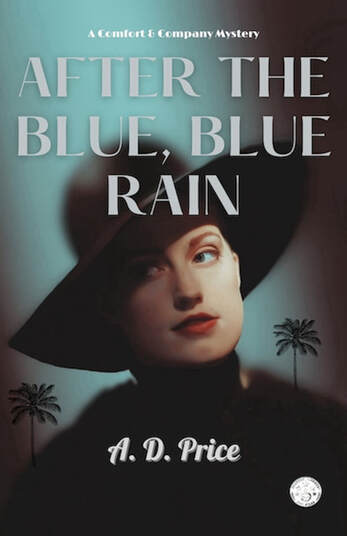 This week we're welcoming historical mystery author A.D. Price to the blog for a guest article on writing mysteries in an ever-changing world and a peek at her debut mystery novel, AFTER THE BLUE, BLUE RAIN. The blog is all yours AD! Oh, Technology by A. D. PriceBefore setting pen to page, or fingers to keyboard, mystery writers have likely settled on a few basics of their story: When the story takes place – contemporary or a particular historical period – and where it takes place. Once the choice between city and country, real place and imaginary, has been made, the writer starts to build the physical world of the mystery, its milieu. And for better or worse, within that physical world, technology is a key element. Technology – defined vaguely as the ways by which people provide themselves with material objects – is a big part of everyday life but it's rarely the stuff of great art. For the mystery reader, descriptions of technology can be soporific. (I recently read a mystery in which the author felt compelled to explain, in detail, how to send and print an email attachment. Ooof!) And for the writer, deciding when and how to describe gadgets and gizmos can be challenging. Fiction is expected to be technologically accurate, but always presented in a "user friendly" way. I chose to write a historical mystery in part because I wanted to avoid the burden of these Information Age details. I knew I'd never be comfortable describing how TikTok works or how Facetune came to be. Forget Crypto or NFTs. And most important, I worried that even if I could master these details, by the time my book came out, they'd already be dated. Fast-moving research and development and the far reach of social media have, I think, altered the landscape of evergreen writing. Not that long ago, a piece of fiction could be evergreen for 50 years as long as the writer avoided specific dates and events. Except for science fiction writers, I suspect few authors back then gave much thought to changing technology, mainly because everyday technology changed very little. Telephones had receivers and cords, letters were delivered by postal workers, kids played with toys, money was kept in pockets and wallets, and books had spines. Nowadays, however, the form and function of our basic tools change almost daily. Not long ago, home security systems with cameras and live video feed were gadgets of the rich. Today, they are ubiquitous in most of America. Come tomorrow, however, they're likely to be taken over by drones and robots. A writer wouldn't need to mention the year or a current event to lose the timelessness of their mystery. Just by including a certain common tool or a popular website, they could be dating their story to a particular year. Does it matter if a contemporary mystery is evergreen? It depends. Some successful authors, like Michael Connelly, embrace the temporal. They literally date their stories, trying to capture in real time society's goings-on. Most contemporary mysteries, however, exist in a vague present, only hinting at current events. The intention, I think, is to be evergreen, but technology sometimes undermines the effort. Even slightly outdated tech references can take the reader out of the story and make them wonder, when was this book written or, worse, how old is this writer? Writers of historical mysteries, of course, don't have that problem. Period technology has the advantage of being knowable and finite. A mystery can be built around its limitations, without worry that a more powerful, smarter device is waiting in the wings, ready to make the impossible, suddenly and uncomfortably possible. Of course, working within the period’s limitations can also be a creative challenge for a writer. What happens when the hero can't pick up their cellphone and text their partner? Or shoot an urgent email request for INTERPOL documents? Or get a DNA profile from a licked stamp? Whether they’re writing about monks in medieval Rome or flappers in 1920s New York, historical mystery writers still have to get their characters from point A to point B, no matter how low-tech the machinery may be. On the other hand, when it comes to climatic suspense sequences, going low-tech is often easier for the writer and more effective for the reader than high-tech options. The more technologically deprived and vulnerable a character is, the harder they have to work to figure out the clues and perhaps save themselves. Dramatic tension builds naturally when hero and villain are reduced to their own wits and bodies for defense. The sophistication of the technology hardly matters. For all its bells and whistles, modern technology rarely, if ever, adds to the drama. In fact, in many contemporary mysteries, suspense-building depends on the characters being deprived of technology: A storm knocks out the electricity, and with it, the Internet; a chase leads to a remote area where cellphone coverage doesn't exist; the GPS tracking device, designed to reveal the bad guy's location, is discovered and removed. Even in spy tales where state-of-the-art technology allows for dazzling espionage, there often comes a point in the plot where the gadgets fail or the villain discovers the dead spots in the satellite feed. The truth is, the power of mysteries usually comes down to the primitive and the instinctive, the will to survive and the innate skills to defeat the odds. In the end, raw brain power and raw brawn, not technology, always win the day.  About the Author: A native of Washington, D. C., A. D. Price lives in Los Angeles with her husband and two dogs. After the Blue, Blue Rain is her first novel, and if there's truth to the old saw about writing being a journey not a destination, then she’s been a happy wanderer for decades. Over the years, she’s worked as both a freelance and staff writer (under her real name, Amy Dunkleberger) penning everything from biographies and historical pieces to publicity material and study guides. She’s also the author of the Emmy-winning screenplay Other Mothers. She looks forward to finishing the next installment in her Comfort & Company detective series. Please visit her website to sign up for her newsletter “Price Writes Monthly.” Website: http://adpricebooks.com Instagram: https://www.instagram.com/adprice22/ Facebook: https://www.facebook.com/profile.php?id=100088827713435 Mastodon: https://toot.community/@LASilverlaker (This is equivalent, alternative to Twitter)  AFTER THE BLUE, BLUE RAIN Genre: historical mystery L.A. 1946. The client is desperate, the target has disappeared into thin air. And what began as a routine missing person case is about to take a dangerous turn for P.I. Kit Comfort and partner Henry Richman, the LAPD's most infamous ex-cop. While on the hunt for a veteran who's gone missing from an L.A.-bound train, detectives Kit and Henry come face-to-face with an underground network of enemy sympathizers. The duo's discovery sets off alarms with the U.S. Army, and soon, the pair are in a race against the clock, battling both a deadly cabal and dodgy government agents. The wounds of war come full circle in this devastating conspiracy between "good and evil." https://www.amazon.com/After-Blue-Rain-D-Price/dp/B0BDBB9GKX Coming to Audible in March, the audiobook version of After the Blue, Blue Rain, narrated by Elizabeth Schmidt. Book Two in the Comfort & Company series, The Birthday of Eternity, arriving fall 2023. Book excerpt can be found HERE in the book spotlight on my Ally Shields blog.Comments are closed.
|
AuthorJ L Buck writes in the mystery genre, currenty enthralled with Regency-era England. She is multi-published in paranormal Check out my profile on AllAuthor (including my Ally Shields fantasy books). Here you can read my books' sample chapters, get updates on my books and latest deals, ask me questions, discuss my books and much more. Follow me on AllAuthor.
https://allauthor.com/author/jlbuck/ Archives
December 2024
Categories
All
|







 RSS Feed
RSS Feed